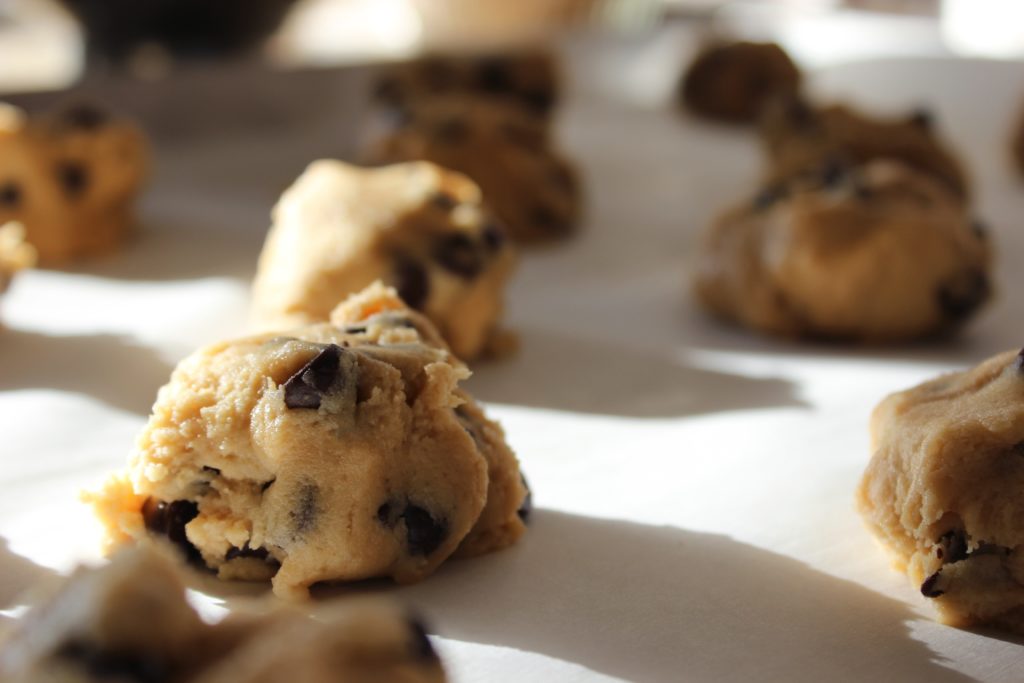All fields are required
Posted in Food Safety,Salmonella on November 14, 2018

The holidays are almost upon us, bringing with them cookies. Lots of cookies. Traditions run deep through the holidays, sugar cookies, gingerbread, and Hamentashen join chocolate chip cookies, M&M cookies, chocolate chews and Snickerdoodles in a decadent parade of cookie swaps that lasts a solid month. With so much baking, it’s a pretty fair bet that there will be sampling of the cookie dough. In fact, snitching cookie dough is incredibly common and for many a cherished part of the whole cookie making experience. Here’s what you need to know about raw cookie dough safety!
The experts, though, throw a bucket of ice water on the fun. Most people know about the possibility of salmonella poisoning from raw eggs, in fact Salmonella is one of the more common sources of food poisoning. The disease caused by the salmonella bacterium is called salmonellosis. The CDC estimates 1.2 million people contract Salmonella every year, and 23,000 are hospitalized. Salmonellosis is also responsible for 450 deaths in the United States every year. Contaminated food is responsible for the lion’s share of salmonellosis: roughly 1 million cases, 19,000 hospitalizations and 380 deaths.
But there is another danger lurking in your raw cookie dough, and it’s the flour. In 2016, E. coli infections linked to raw flour made 63 people sick, 17 of whom were hospitalized (mercifully, no deaths were reported). E.coli is a bacteria that lives in the intestines of people and animals, and most E.coli is harmless. In fact, most E.coli strains are an important part of the intestinal track. However, a few strains can cause severe abdominal cramps, bloody diarrhea and vomiting.
E.coli poisoning is more commonly associated with ground beef and contaminated water, but it has also been linked to flour, much to everyone’s chagrin.
E. coli infection typically manifests symptoms three or four days after you’ve been exposed to the bacteria. However, it may manifest as soon as one day after, or as long as seven days after. Symptoms include:
If you or a loved one, particularly an at-risk loved one like a child, develops these symptoms, don’t hesitate to see a doctor to be tested for E.coli poisoning. The Mayo clinic notes that most healthy adults will recover from E.coli poisoning within a week, but children or elderly run the risk of developing life-threatening kidney failure known as hemolytic uremic syndrome.
Salmonella poisoning is a little faster acting: Most people who contract Salmonella poisoning develop diarrhea, fever and abdominal cramps 12 to 72 hours after infection. Illness typically lasts 4 to 7 days, and most people recover without treatment.
Symptoms include:
Occasionally the symptoms are so severe that the sick person must be hospitalized-often due to severe dehydration. In worse cases, the bacterial infection can spread from the intestines into the bloodstream, and from there to other parts of the body. In these instances, Salmonella can cause death in a variety of unpleasant ways unless it is treated with antibiotics.
There is no vaccine for salmonellosis, or for E.coli poisoning. Though they are trying to develop E.coli vaccines. The CDC provides some guidelines for handling dough:
While snitching raw cookie dough should be foregone, the raw cookie dough experience doesn’t have to go away entirely. Since the announcement of the 2016 outbreak, bakers on the internet have lent their expertise to the problem. The solution? Use an eggless recipe and cook the flour before mixing it into the dough. Toast the flour in the oven at 350°F for about 5 minutes, until its internal temperature reaches 160°F. Then you can mix it with sugar, butter, and vanilla and eat a spoonful.
It’s a little extra work, but it’s safer and quite tasty.
Try out this raw cookie dough recipe from What Molly Made:
Ingredients
1 cup brown sugar
1/4 cup granulated sugar
1 cup unsalted butter softened to room temperature
2 1/2 teaspoons vanilla extract
1 teaspoon salt
2 cups all purpose flour
2 tablespoons milk plus more if needed
1 cup miniature chocolate chips
Instructions
Heat treat your flour by placing it in a microwave safe bowl and heating on high for 50-60 seconds until the internal temperature reaches 166°F. Alternatively, spread flour on a cookie sheet and bake at 350°F for roughly 5 minutes until internal temperature reaches 166°F.
In a large bowl using a hand mixer or stand mixer, cream together the brown sugar, granulated sugar, and butter. Beat until fluffy and light in color, about 1 minute. Beat in the vanilla and salt until combined.
Beat in flour until just combined. Add milk one tablespoon at a time and beat until dough starts to come together. Stir in the miniature chocolate chips with rubber spatula.
This batter does not have eggs, baking soda or powder, so it will not rise or cook well. This is a raw dough recipe.
Enjoy your holiday season and baking, and keep a bowl of safe raw dough to keep temptation at bay.
By: Abigail Cossette Ryan, Contributing Writer (Non-Lawyer)